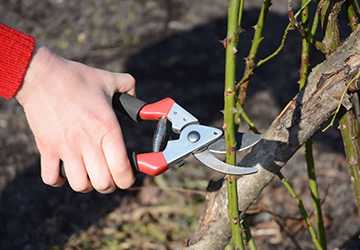Roses, with their enchanting beauty and captivating fragrance, are a favorite of gardeners worldwide. However, to ensure they thrive and present their best bloom, following a proper rose care schedule is essential. Pruning is an art and science among the crucial activities in rose maintenance. But when is the perfect time for pruning roses? Let's dive deep into the pruning guide to discover the best time to trim roses.
Understanding the Importance of Pruning
Before exploring the ideal times, it's crucial to comprehend why pruning roses is essential.
● Health: Removing dead or diseased wood promotes better air circulation, reducing the risk of fungal diseases.
● Shape: Pruning helps maintain a balanced, open shape, ensuring roses look attractive even when not blooming.
● Vigor: Regular trimming encourages new growth, producing more robust plants and better flower production.

Rose Care Schedule: Seasonal Guide
Roses, much like other plants, respond to seasonal changes. The rose care schedule varies based on these seasons, and the rose you have.
1. Late Winter to Early Spring: This period, right before the plant breaks dormancy, is the best time to trim roses for many varieties, especially hybrid teas, floribundas, and grandifloras. You'd want to prune just before the last frost, ensuring the plant directs its energy towards new growth.
2. Summer: Once the season's first bloom is done, it's a good time for light pruning. This summer trim ensures the rose bush remains vibrant and prepares it for the next bloom cycle.
3. Autumn: Generally, heavy pruning in autumn isn't recommended. However, you can remove any diseased or dead branches. Refrain from severe cuts, which might encourage new growth that winter frosts could damage.
Pruning Guide: Techniques and Tips
Knowing the best time to trim roses is just part of the equation. How you prune is equally crucial.
● Begin with the Right Tools: Sharp secateurs, protective gloves, and pruning saws for thicker canes are essential.
● Look for the Outward-Facing Bud: Choose a spot above an outward-facing bud when making cuts. This encourages growth away from the center of the plant.
● Angle the Cut: Ensure your cut is at a 45-degree angle, about 1/4 inch above the bud. This prevents water from settling on the bud, reducing disease risks.
● Remove Dead Wood: Anything that looks brown and feels too hard or brittle should be removed.
Factors Affecting the Best Time to Trim Roses
While the abovementioned general rose care schedule works for most regions, certain factors can affect the best time to trim roses.
● Climate: In warmer areas with mild winters, you might prune a bit earlier than in colder regions.
● Rose Variety: Some species, like old garden roses, prefer being pruned after they bloom in the spring.
● Weather Patterns: An unexpected late frost can damage newly pruned roses, so always watch the forecast.
Classifying Roses for Pruning
To determine the best time to trim roses, one must first understand the different types of roses, as pruning schedules can vary significantly among them.
● Hybrid Teas, Grandifloras, and Floribundas: Late winter to early spring is ideal. These roses bloom on new growth, so timely pruning ensures a season full of blooms.
● Shrub Roses: These are typically hardier and can be pruned in both spring and after the summer bloom.
● Climbing Roses: While they may require some spring touch-ups, the main pruning period is after their main bloom in summer.
● Old Garden Roses: These bloom on old wood, so it's crucial only to prune them after their spring flowering to avoid cutting off potential buds.
Rose Care Schedule: Addressing Common Concerns
A comprehensive rose care schedule involves more than knowing the best time to trim roses.
● Watering: While pruning helps rejuvenate rose plants, adequate water is essential for recovery and growth. Early morning is the best time, ensuring the leaves are dry by evening, reducing fungal risks.
● Fertilizing: After your primary spring pruning, giving roses a good feed is beneficial. This helps kickstart their growth for the season.
● Mulching: Post-pruning, ensure the base of your roses is well-mulched. This conserves moisture, suppresses weeds, and stabilizes soil temperatures.

Common Mistakes in Pruning
Knowing common pruning errors is as crucial as knowing the pruning guide.
● Over-Pruning: While roses are resilient, taking off too much can stress the plant. It's a balance between removing the old and encouraging the new.
● Late Pruning: Waiting too long, especially for varieties that bloom on new growth, can delay and reduce the flowering period.
● Ignoring Diseased Canes: Not removing or improperly cutting diseased or infested parts can spread the ailment.
Benefits of Pruning Roses
Beyond the obvious health benefits for the rose plant, regular pruning offers several advantages:
● Enhanced Flower Size: Regular pruning, especially for types like hybrid teas, can lead to larger, more spectacular blooms.
● Increased Air Circulation: Pruning, particularly thinning out the middle, reduces the risk of diseases like powdery mildew or black spots.
● Landscape Aesthetics: A well-pruned rose bush looks tidy and can be a centerpiece in any garden, enhancing the overall aesthetic appeal.
Essential Tools for Effective Rose Pruning
Having the right tools is as crucial as knowing the best time to trim roses in rose gardening. Your rose care schedule should start with investing in high-quality pruning shears for clean cuts, which promote quicker healing. A pair of long gloves will protect your hands from thorns and possible infections. Additionally, consider a pruning saw for older, thicker canes and loppers for reaching deeper into the bush or handling larger branches. Proper maintenance of these tools, including regular cleaning and sharpening, ensures they remain effective and extend the health and beauty of your roses.
Conclusion
Embarking on the journey of rose cultivation is immensely rewarding. By adhering to a proper rose care schedule and understanding the intricacies of the pruning guide, one can ensure their roses remain healthy, vibrant, and ever-beautiful. Remember, the best time to trim roses may vary based on several factors, but the end goal is always the same: a thriving rose bush that's a sight to behold.


